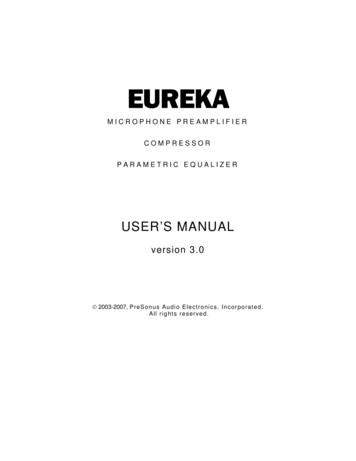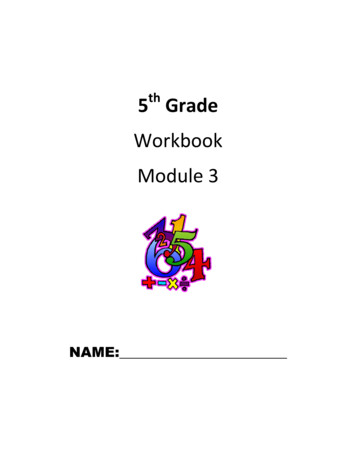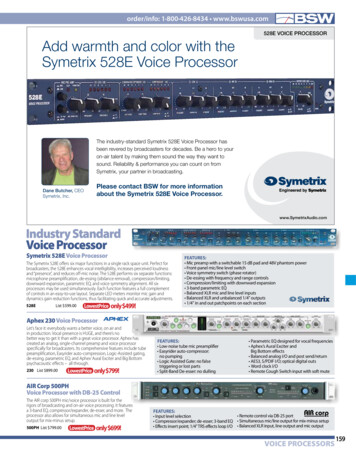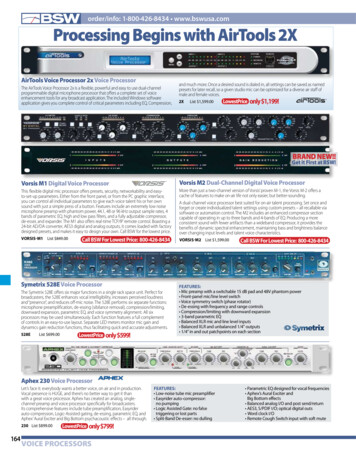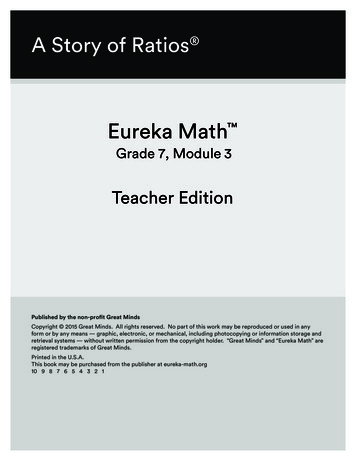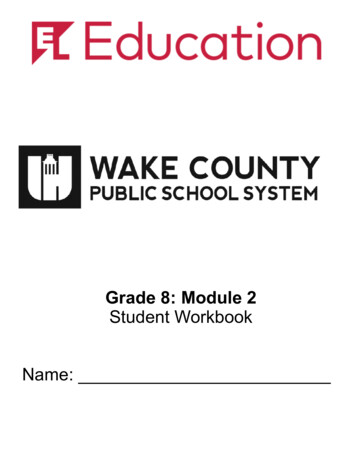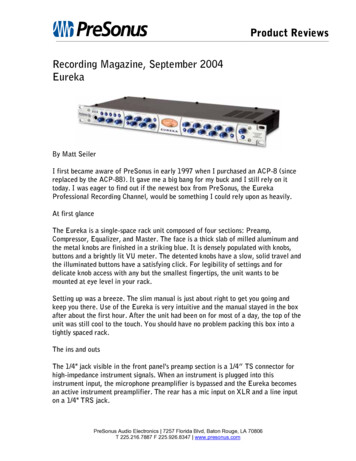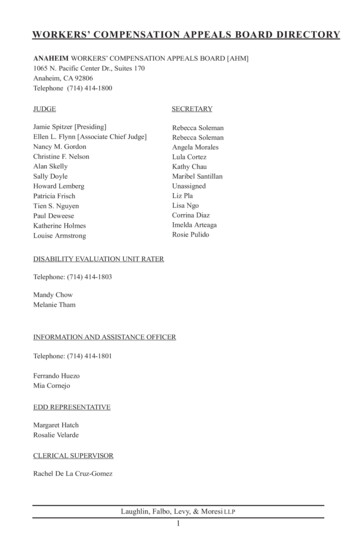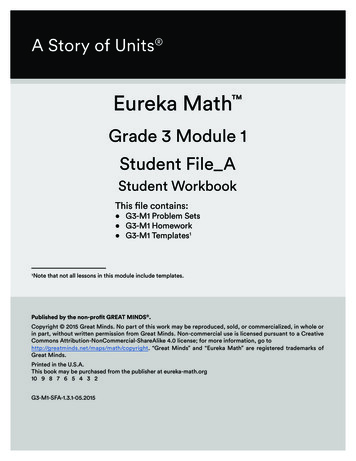
Transcription
A Story of Units Eureka Math Grade 3 Module 1Student File AStudent WorkbookThis file contains: G3-M1 Problem Sets G3-M1 Homework G3-M1 Templates11Note that not all lessons in this module include templates.Published by the non-profit GREAT MINDS .Copyright 2015 Great Minds. No part of this work may be reproduced, sold, or commercialized, in whole orin part, without written permission from Great Minds. Non-commercial use is licensed pursuant to a CreativeCommons Attribution-NonCommercial-ShareAlike 4.0 license; for more information, go tohttp://greatminds.net/maps/math/copyright. “Great Minds” and “Eureka Math” are registered trademarks ofGreat Minds.Printed in the U.S.A.This book may be purchased from the publisher at eureka-math.org10 9 8 7 6 5 4 3 2G3-M1-SFA-1.3.1-05.2015
Lesson 1 Problem Set 3 1A STORY OF UNITSNameDate1. Fill in the blanks to make true statements.b. 3 3 3 3 3 a. 3 groups of five 3 fives 5 groups of three 3 5 5 3 c. 6 6 6 6 groups of six 4 d. 4 6 groups of 6 Lesson 1:Understand equal groups of as multiplication. 2015 Great Minds. eureka-math.org1
Lesson 1 Problem Set 3 1A STORY OF UNITS2. The picture below shows 2 groups of apples. Does the picture show 2 3? Explain why or why not.3. Draw a picture to show 2 3 6.4. Caroline, Brian, and Marta share a box of chocolates. They each get the same amount. Circle thechocolates below to show 3 groups of 4. Then, write a repeated addition sentence and a multiplicationsentence to represent the picture.Lesson 1:Understand equal groups of as multiplication. 2015 Great Minds. eureka-math.org2
Lesson 1 Homework 3 1A STORY OF UNITSNameDate1. Fill in the blanks to make true statements.a. 4 groups of five b. 5 groups of four 4 fives 5 fours 4 5 5 4 c. 6 6 6 d. 3 groups of six 6 groups of 3 6 Lesson 1:Understand equal groups of as multiplication. 2015 Great Minds. eureka-math.org3
Lesson 1 Homework 3 1A STORY OF UNITS2. The picture below shows 3 groups of hot dogs. Does the picture show 3 3? Explain why or why not.3. Draw a picture to show 4 2 8.4. Circle the pencils below to show 3 groups of 6. Write a repeated addition and a multiplication sentenceto represent the picture.Lesson 1:Understand equal groups of as multiplication. 2015 Great Minds. eureka-math.org4
Lesson 2 Problem Set 3 1A STORY OF UNITSNameDateUse the arrays below to answer each set of questions.1.a. How many rows of cars are there?b. How many cars are there in each row?a. What is the number of rows?2.b. What is the number of objects in each row?3.a. There are 4 spoons in each row. How many spoons are in 2 rows?b. Write a multiplication expression to describe the array.4.a. There are 5 rows of triangles. How many triangles are in each row?b. Write a multiplication expression to describe the total number of triangles.Lesson 2:Relate multiplication to the array model. 2015 Great Minds. eureka-math.org5
Lesson 2 Problem Set 3 1A STORY OF UNITS5. The dots below show 2 groups of 5.a. Redraw the dots as an array that shows 2 rows of 5.b. Compare the drawing to your array. Write at least 1 reason why they are the sameand 1 reason why they are different.6. Emma collects rocks. She arranges them in 4 rows of 3. Draw Emma’s array to show how many rocks shehas altogether. Then, write a multiplication equation to describe the array.7. Joshua organizes cans of food into an array. He thinks, “My cans show 5 3!” Draw Joshua’s array to findthe total number of cans he organizes.Lesson 2:Relate multiplication to the array model. 2015 Great Minds. eureka-math.org6
Lesson 2 Homework 3 1A STORY OF UNITSNameDateUse the arrays below to answer each set of questions.1.a. How many rows of erasers are there?b. How many erasers are there in each row?a. What is the number of rows?2.b. What is the number of objects in each row?3.a. There are 3 squares in each row. How many squares are in 5 rows?b. Write a multiplication expression to describe the array.a. There are 6 rows of stars. How many stars are in each row?4.b. Write a multiplication expression to describe the array.Lesson 2:Relate multiplication to the array model. 2015 Great Minds. eureka-math.org7
Lesson 2 Homework 3 1A STORY OF UNITS5. The triangles below show 3 groups of four.a. Redraw the triangles as an array that shows 3 rows of four.b. Compare the drawing to your array. How are they the same?How are they different?6. Roger has a collection of stamps. He arranges the stamps into 5 rows of four. Draw an array to representRoger’s stamps. Then, write a multiplication equation to describe the array.7. Kimberly arranges her 18 markers as an array. Draw an array that Kimberly might make. Then, write amultiplication equation to describe your array.Lesson 2:Relate multiplication to the array model. 2015 Great Minds. eureka-math.org8
Lesson 2 Template 3 1A STORY OF UNITSthrees arrayLesson 2:Relate multiplication to the array model. 2015 Great Minds. eureka-math.org9
Lesson 3 Problem Set 3 1A STORY OF UNITSNameDateSolve Problems 1–4 using the pictures provided for each problem.1. There are 5 flowers in each bunch. How many flowers are in 4 bunches?a. Number of groups:Size of each group:b. 4 5 c. There are flowers altogether.2. There are candies in each box. How many candies are in 6 boxes?a. Number of groups:Size of each group:b. 6 c. There are candies altogether.3. There are 4 oranges in each row. How many oranges are there in rows?a. Number of rows:Size of each row:b. 4 c. There are oranges altogether.Lesson 3:Interpret the meaning of factors—the size of the group or the numberof groups. 2015 Great Minds. eureka-math.org10
Lesson 3 Problem Set 3 1A STORY OF UNITS4. There are loaves of bread in each row. How many loaves of bread are there in 5 rows?a. Number of rows:Size of each row:b. c. There are loaves of bread altogether.5. a. Write a multiplication equation for the array shown below.XXXXXXXXXXXXb. Draw a number bond for the array where each part represents the amount in one row.6. Draw an array using factors 2 and 3. Then, show a number bond where each part represents the amountin one row.Lesson 3:Interpret the meaning of factors—the size of the group or the numberof groups. 2015 Great Minds. eureka-math.org11
Lesson 3 Homework 3 1A STORY OF UNITSNameDateSolve Problems 1–4 using the pictures provided for each problem.1. There are 5 pineapples in each group. How many pineapples are there in 5 groups?a. Number of groups:Size of each group:b. 5 5 c. There are pineapples altogether.2. There are apples in each basket. How many apples are there in 6 baskets?a. Number of groups:Size of each group:b. 6 c. There are apples altogether.Lesson 3:Interpret the meaning of factors—the size of the group or the numberof groups. 2015 Great Minds. eureka-math.org12
Lesson 3 Homework 3 1A STORY OF UNITS3. There are 4 bananas in each row. How many bananas are there in rows?a. Number of rows: Size of each row:b. 4 c. There are bananas altogether.4. There are peppers in each row. How many peppers are there in 6 rows?a. Number of rows: Size of each row:b. c. There are peppers altogether.5. Draw an array using factors 4 and 2. Then, show a number bond where each part represents the amountin one row.Lesson 3:Interpret the meaning of factors—the size of the group or the numberof groups. 2015 Great Minds. eureka-math.org13
Lesson 4 Problem Set 3 1A STORY OF UNITSNameDate1.2.14 flowers are divided into 2 equal groups.28 books are divided into 4 equal groups.There are flowers in each group.There are books in each group.3.4.30 apples are divided into equalgroups.cups are divided into equal groups.There are apples in each group.12 2 5.There are cups in each group.6.There are toys in each group.9 3 15 3 Lesson 4:Understand the meaning of the unknown as the size of the group indivision. 2015 Great Minds. eureka-math.org14
Lesson 4 Problem Set 3 1A STORY OF UNITS7. Audrina has 24 colored pencils. She puts them in 4 equal groups. How many colored pencils are in eachgroup?There are colored pencils in each group.24 4 8. Charlie picks 20 apples. He divides them equally between 5 baskets. Draw the apples in each basket.There are apples in each basket.20 9. Chelsea collects butterfly stickers. The picture shows how she placed them in herbook. Write a division sentence to show how she equally grouped her stickers.There are butterflies in each row. Lesson 4:Understand the meaning of the unknown as the size of the group indivision. 2015 Great Minds. eureka-math.org15
Lesson 4 Homework 3 1A STORY OF UNITSNameDate1.2.12 chairs are divided into 2 equal groups.21 triangles are divided into 3 equal groups.There are chairs in each group.There are triangles in each group.3.4.25 erasers are divided into equalgroups.chickens are divided into equal groups.There are chickens in each group.There are erasers in each group.9 3 5.6.There are buckets in each group.16 4 12 4 Lesson 4:Understand the meaning of the unknown as the size of the group indivision. 2015 Great Minds. eureka-math.org16
Lesson 4 Homework 3 1A STORY OF UNITS7. Andrew has 21 keys. He puts them in 3 equal groups. How many keys are in each group?There are keys in each group.21 3 8. Mr. Doyle has 20 pencils. He divides them equally between 4 tables. Draw the pencils on each table.There are pencils on each table.20 9. Jenna has markers. The picture shows how she placed them on her desk. Write a division sentence torepresent how she equally grouped her markers.There are markers in each row. Lesson 4:Understand the meaning of the unknown as the size of the group indivision. 2015 Great Minds. eureka-math.org17
Lesson 5 Problem Set 3 1A STORY OF UNITSNameDate1.2.Divide 6 tomatoes into groups of 3.Divide 8 lollipops into groups of 2.There are groups of 3 tomatoes.There are groups.6 3 28 2 3.4.Divide 10 stars into groups of 5.Divide the shells to show 12 3 ,where the unknown represents the number ofgroups.10 5 How many groups are there?Lesson 5:Understand the meaning of the unknown as the number of groups indivision. 2015 Great Minds. eureka-math.org18
Lesson 5 Problem Set 3 1A STORY OF UNITS5. Rachel has 9 crackers. She puts 3 crackers in each bag. Circle the crackers to show Rachel’s bags.a. Write a division sentence where the answer represents the number of Rachel’s bags.b. Draw a number bond to represent the problem.6. Jameisha has 16 wheels to make toy cars. She uses 4 wheels for each car.a. Use a count-by to find the number of cars Jameisha can build. Make a drawing to match yourcounting.b. Write a division sentence to represent the problem.Lesson 5:Understand the meaning of the unknown as the number of groups indivision. 2015 Great Minds. eureka-math.org19
Lesson 5 Homework 3 1A STORY OF UNITSNameDate1.2.Divide 4 triangles into groups of 2.Divide 9 eggs into groups of 3.There are groups of 2 triangles.There are groups.9 3 4 2 23.4.Divide 12 buckets of paint into groups of 3.Group the squares to show 15 5 ,where the unknown represents the number ofgroups.12 3 How many groups are there?Lesson 5:Understand the meaning of the unknown as the number of groups indivision. 2015 Great Minds. eureka-math.org20
Lesson 5 Homework 3 1A STORY OF UNITS5. Daniel has 12 apples. He puts 6 apples in each bag. Circle the apples to find the number of bags Danielmakes.a. Write a division sentence where the answer represents the number of Daniel’s bags.b. Draw a number bond to represent the problem.6. Jacob draws cats. He draws 4 legs on each cat for a total of 24 legs.a. Use a count-by to find the number of cats Jacob draws. Make a drawing to match your counting.b. Write a division sentence to represent the problem.Lesson 5:Understand the meaning of the unknown as the number of groups indivision. 2015 Great Minds. eureka-math.org21
Lesson 6 Problem Set 3 1A STORY OF UNITSNameDate1. Rick puts 15 tennis balls into cans. Each can holds 3 balls. Circle groups of 3 to show the balls in each can.Rick needs cans. 3 1515 3 2. Rick uses 15 tennis balls to make 5 equal groups. Draw to show how many tennis balls are in each group.There are tennis balls in each group.5 1515 5 3. Use an array to model Problem 1.a. 3 15b. 5 1515 3 15 5 The number in the blanks representsThe number in the blanks represents.Lesson 6:Interpret the unknown in division using the array model. 2015 Great Minds. eureka-math.org22
Lesson 6 Problem Set 3 1A STORY OF UNITS4. Deena makes 21 jars of tomato sauce. She puts 7 jars in each box to sell at the market. How many boxesdoes Deena need?21 7 7 21What is the meaning of the unknown factor and quotient?5. The teacher gives the equation 4 12. Charlie finds the answer by writing and solving12 4 . Explain why Charlie’s method works.6. The blanks in Problem 5 represent the size of the groups. Draw an array to represent the equations.Lesson 6:Interpret the unknown in division using the array model. 2015 Great Minds. eureka-math.org23
Lesson 6 Homework 3 1A STORY OF UNITSNameDate1. Mr. Hannigan puts 12 pencils into boxes. Each box holds 4 pencils. Circle groups of 4 to show the pencilsin each box.Mr. Hannigan needs boxes. 4 1212 4 2. Mr. Hannigan places 12 pencils into 3 equal groups. Draw to show how many pencils are in each group.There are pencils in each group.3 1212 3 3. Use an array to model Problem 1.a. 4 12b. 3 1212 4 12 3 The number in the blanks representsThe number in the blanks represents.Lesson 6:Interpret the unknown in division using the array model. 2015 Great Minds. eureka-math.org24
Lesson 6 Homework 3 1A STORY OF UNITS4. Judy washes 24 dishes. She then dries and stacks the dishes equally into 4 piles. How many dishes are ineach pile?24 4 4 24What is the meaning of the unknown factor and quotient?5. Nate solves the equation 5 15 by writing and solving 15 5 . Explain why Nate’s methodworks.6. The blanks in Problem 5 represent the number of groups. Draw an array to represent the equations.Lesson 6:Interpret the unknown in division using the array model. 2015 Great Minds. eureka-math.org25
Lesson 7 Problem Set 3 1A STORY OF UNITSNameDate1. a. Draw an array that shows 6 rows of 2.b. Write a multiplication sentence where the firstfactor represents the number of rows. 2. a. Draw an array that shows 2 rows of 6.b. Write a multiplication sentence where the firstfactor represents the number of rows. 3. a. Turn your paper to look at the arrays in Problems 1 and 2 in different ways. What is the same andwhat is different about them?b. Why are the factors in your multiplication sentences in a different order?4. Write a multiplication sentence for each expression. You might skip-count to find the totals.a. 6 twos: 6 2 12d. 2 sevens:Extension:b. 2 sixes:e. 9 twos:g. 11 twos:c. 7 twos:f. 2 nines:h. 2 twelves:Lesson 7:Demonstrate the commutativity of multiplication, and practice relatedfacts by skip-counting objects in array models. 2015 Great Minds. eureka-math.org26
Lesson 7 Problem Set 3 1A STORY OF UNITS5. Write and solve multiplication sentences where the second factor represents the size of the row.6. Ms. Nenadal writes 2 7 7 2 on the board. Do you agree or disagree? Draw arrays to help explainyour thinking.7. Find the missing factor to make each equation true.5 2 2 8 8 22 10 22 9 28. Jada gets 2 new packs of erasers. Each pack has 6 erasers in it.a. Draw an array to show how many erasers Jada has altogether.b. Write and solve a multiplication sentence to describe the array.c. Use the commutative property to write and solve a different multiplication sentence for the array.Lesson 7:Demonstrate the commutativity of multiplication, and practice relatedfacts by skip-counting objects in array models. 2015 Great Minds. eureka-math.org27
Lesson 7 Homework 3 1A STORY OF UNITSNameDate1. a. Draw an array that shows 7 rows of 2.b. Write a multiplication sentence where thefirst factor represents the number of rows. 2. a. Draw an array that shows 2 rows of 7.b. Write a multiplication sentence where thefirst factor represents the number of rows. 3. a. Turn your paper to look at the arrays in Problems 1 and 2 in different ways. What is the same and whatis different about them?b. Why are the factors in your multiplication sentences in a different order?4. Write a multiplication sentence to match the number of groups. Skip-count to find the totals. The firstone is done for you.a. 2 twos: 2 2 4d. 2 fours:g. 2 fives:b. 3 twos:e. 4 twos:h. 6 twos:c. 2 threes:f. 5 twos:i. 2 sixes:Lesson 7:Demonstrate the commutativity of multiplication, and practice relatedfacts by skip-counting objects in array models. 2015 Great Minds. eureka-math.org28
Lesson 7 Homework 3 1A STORY OF UNITS5. Write and solve multiplication sentences where the second factor represents the size of the row.6. Angel writes 2 8 8 2 in his notebook. Do you agree or disagree? Draw arrays to help explain yourthinking.7. Find the missing factor to make each equation true.2 6 6 2 2 79 2 92 10 28. Tamia buys 2 bags of candy. Each bag has 7 pieces of candy in it.a. Draw an array to show how many pieces of candy Tamia has altogether.b. Write and solve a multiplication sentence to describe the array.c. Use the commutative property to write and solve a different multiplication sentence for the array.Lesson 7:Demonstrate the commutativity of multiplication, and practice relatedfacts by skip-counting objects in array models. 2015 Great Minds. eureka-math.org29
Lesson 8 Problem Set 3 1A STORY OF UNITSNameDate1. Draw an array that shows 5 rows of 3.2. Draw an array that shows 3 rows of 5.3. Write multiplication expressions for the arrays in Problems 1 and 2. Let the first factor in each expressionrepresent the number of rows. Use the commutative property to make sure the equation below is true. Problem 1Problem 24. Write a multiplication sentence for each expression. You might skip-count to find the totals. The first oneis done for you.a. 2 threes:2 3 6d. 4 threes:g. 3 nines:b. 3 twos:e. 3 sevens:h. 9 threes:c. 3 fours:f. 7 threes:i. 10 threes:5. Find the unknowns that make the equations true. Then, draw a line to match related facts.a. 3 3 3 3 3 d. 3 8 b. 3 9 e. 5 3c. 7 threes 1 three f. 27 9 Lesson 8:Demonstrate the commutativity of multiplication, and practice relatedfacts by skip-counting objects in array models. 2015 Great Minds. eureka-math.org30
Lesson 8 Problem Set 3 1A STORY OF UNITS6. Isaac picks 3 tangerines from his tree every day for 7 days.a. Use circles to draw an array that represents the tangerines Isaac picks.b. How many tangerines does Isaac pick in 7 days? Write and solve a multiplication sentence to find thetotal.c. Isaac decides to pick 3 tangerines every day for 3 more days. Draw x’s to show the new tangerines onthe array in Part (a).d. Write and solve a multiplication sentence to find the total number of tangerines Isaac picks.7. Sarah buys bottles of soap. Each bottle costs 2.a. How much money does Sarah spend if she buys 3 bottles of soap? b. How much money does Sarah spend if she buys 6 bottles of soap? Lesson 8:Demonstrate the commutativity of multiplication, and practice relatedfacts by skip-counting objects in array models. 2015 Great Minds. eureka-math.org31
Lesson 8 HomeworkA STORY OF UNITSName3 1Date1. Draw an array that shows 6 rows of 3.2. Draw an array that shows 3 rows of 6.3. Write multiplication expressions for the arrays in Problems 1 and 2. Let the first factor in each expressionrepresent the number of rows. Use the commutative property to make sure the equation below is true. Problem 1Problem 24. Write a multiplication sentence for each expression. You might skip-count to find the totals. The first oneis done for you.a. 5 threes: 5 3 15d. 3 sixes: g. 8 threes:b. 3 fives: e. 7 threes: h. 3 nines:c. 6 threes: f. 3 sevens: i. 10 threes:5. Find the unknowns that make the equations true. Then, draw a line to match related facts.a. 3 3 3 3 3 3 d. 3 9 b. 3 5 e. 6 3c. 8 threes 1 three f. 15 5 Lesson 8:Demonstrate the commutativity of multiplication, and practice relatedfacts by skip-counting objects in array models. 2015 Great Minds. eureka-math.org32
Lesson 8 HomeworkA STORY OF UNITS3 16. Fernando puts 3 pictures on each page of his photo album. He puts pictures on 8 pages.a. Use circles to draw an array that represents the total number of pictures in Fernando’s photo album.b. Use your array to write and solve a multiplication sentence to find Fernando’s total number ofpictures.c. Fernando adds 2 more pages to his book. He puts 3 pictures on each new page. Draw x’s to show thenew pictures on the array in Part (a).d. Write and solve a multiplication sentence to find the new total number of pictures in Fernando’salbum.7. Ivania recycles. She gets 3 cents for every can she recycles.a. How much money does Ivania make if she recycles 4 cans? centsb. How much money does Ivania make if she recycles 7 cans? centsLesson 8:Demonstrate the commutativity of multiplication, and practice relatedfacts by skip-counting objects in array models. 2015 Great Minds. eureka-math.org33
Quality Control GuideLesson 9 Problem Set 3 1A STORY OF UNITSNameDate1. The team organizes soccer balls into 2 rows of 5. The coach adds 3 rows of 5 soccer balls. Complete theequations to describe the total array.a. (5 5) (5 5 5) b. 2 fives fives fivesc. 5 3. 9 2 2. 7 2 5 2 10 2 2 2 10 4 2 141 2 20 – 189 2 Lesson 9:Find related multiplication facts by adding and subtracting equalgroups in array models. 2015 Great Minds. eureka-math.org34
Quality Control GuideLesson 9 Problem Set 3 1A STORY OF UNITS4. Matthew organizes his baseball cards in 4 rows of 3.a. Draw an array that represents Matthew’s cards using an x to show each card.b. Solve the equation to find Matthew’s total number of cards. 4 3 5. Matthew adds 2 more rows. Use circles to show his new cards on the array in Problem 4(a).a. Write and solve a multiplication equation to represent the circles you added to the array. 3 b. Add the totals from the equations in Problems 4(b) and 5(a) to find Matthew’s total cards. 18c. Write the multiplication equation that shows Matthew’s total number of cards. 18Lesson 9:Find related multiplication facts by adding and subtracting equalgroups in array models. 2015 Great Minds. eureka-math.org35
Quality Control GuideLesson 9 Homework 3 1A STORY OF UNITSNameDate1. Dan organizes his stickers into 3 rows of four. Irene adds 2 more rows of stickers. Complete theequations to describe the total number of stickers in the array.a. (4 4 4) (4 4) b. 3 fours fours foursc. 4 2. 7 2 3.9 3 6 2 10 3 1 2 1 3 12 2 2 1430 – 27 3 27Lesson 9:Find related multiplication facts by adding and subtracting equalgroups in array models. 2015 Great Minds. eureka-math.org36
Quality Control GuideLesson 9 Homework 3 1A STORY OF UNITS4. Franklin collects stickers. He organizes his stickers in 5 rows of four.a. Draw an array to represent Franklin’s stickers. Use an x to show each sticker.b. Solve the equation to find Franklin’s total number of stickers. 5 4 5. Franklin adds 2 more rows. Use circles to show his new stickers on the array in Problem 4(a).a. Write and solve an equation to represent the circles you added to the array. 4 b. Complete the equation to show how you add the totals of 2 multiplication facts to find Franklin’s totalnumber of stickers. 28c. Complete the unknown to show Franklin’s total number of stickers. 4 28Lesson 9:Find related multiplication facts by adding and subtracting equalgroups in array models. 2015 Great Minds. eureka-math.org37
Quality Control GuideLesson 9 Template 3 1A STORY OF UNITSthrees array no fillLesson 9:Find related multiplication facts by adding and subtracting equalgroups in array models. 2015 Great Minds. eureka-math.org38
Lesson 10 Problem Set 3 1A STORY OF UNITSNameDate1. 7 3 (5 3) (2 3) 2. 8 3 (4 3) (4 3) ( 3) (5 3) 15(2 3) ( 3) (5 3) (2 3) 15 15 (4 3) (4 3) 3 Lesson 10:Model the distributive property with arrays to decompose units as astrategy to multiply. 2015 Great Minds. eureka-math.org39
Lesson 10 Problem Set 3 1A STORY OF UNITS3. Ruby makes a photo album. One page is shown below. Ruby puts 3 photos in each row.a. Fill in the equations on the right. Use them to help you draw arrays that show the photos on the topand bottom parts of the page. 3 6 3 9b. Ruby calculates the total number of photos as shown below. Use the array you drew to help explainRuby’s calculation.5 3 6 9 15Lesson 10:Model the distributive property with arrays to decompose units as astrategy to multiply. 2015 Great Minds. eureka-math.org40
Lesson 10 Homework 3 1A STORY OF UNITSNameDate1. 6 3 (4 3) 12(2 3) 12 6 3 2. 8 2 ( 2) ( 2) (4 2) (4 2) 2 Lesson 10:Model the distributive property with arrays to decompose units as astrategy to multiply. 2015 Great Minds. eureka-math.org41
Lesson 10 Homework 3 1A STORY OF UNITS3. Adriana organizes her books on shelves. She puts 3 books in each row.a. Fill in the equations on the right. Use them to draw arrays that show the books on Adriana’s top andbottom shelves. 3 15 3 3b. Adriana calculates the total number of books as shown below. Use the array you drew to help explainAdriana’s calculation.6 3 15 3 18Lesson 10:Model the distributive property with arrays to decompose units as astrategy to multiply. 2015 Great Minds. eureka-math.org42
Lesson 11 Problem Set 3 1A STORY OF UNITSNameDate1. Mrs. Prescott has 12 oranges. She puts 2 oranges in each bag. How many bags does she have?a. Draw an array where each column shows a bag of oranges. 2 b. Redraw the oranges in each bag as a unit in the tape diagram. The first unit is done for you. As youdraw, label the diagram with known and unknown information from the problem.2. Mrs. Prescott arranges 18 plums into 6 bags. How many plums are in each bag? Model the problem withboth an array and a labeled tape diagram. Show each column as the number of plums in each bag.There are plums in each bag.Lesson 11:Model division as the unknown factor in multiplication using arraysand tape diagrams. 2015 Great Minds. eureka-math.org43
Lesson 11 Problem Set 3 1A STORY OF UNITS3. Fourteen shopping baskets are stacked equally in 7 piles. How many baskets are in each pile? Model theproblem with both an array and a labeled tape diagram. Show each column as the number of baskets ineach pile.4. In the back of the store, Mr. Prescott packs 24 bell peppers equally into 8 bags. How many bell peppersare in each bag? Model the problem with both an array and a labeled tape diagram. Show each columnas the number of bell peppers in each bag.5. Olga saves 2 a week to buy a toy car. The car costs 16. How many weeks will it take her to saveenough to buy the toy?Lesson 11:Model division as the unknown factor in multiplication using arraysand tape diagrams. 2015 Great Minds. eureka-math.org44
Lesson 11 Homework 3 1A STORY OF UNITSNameDate1. Fred has 10 pears. He puts 2 pears in each basket. How many baskets does he have?a. Draw an array where each column represents the number of pears in each basket. 2 b. Redraw the pears in each basket as a unit in the tape diagram. Label the diagram with known andunknown information from the problem.2. Ms. Meyer organizes 15 clipboards equally into 3 boxes. How many clipboards are in each box? Modelthe problem with both an array and a labeled tape diagram. Show each column as the number ofclipboards in each box.There are clipboards in each box.Lesson 11:Model division as the unknown factor in multiplication using arraysand tape diagrams. 2015 Great Minds. eureka-math.org45
Lesson 11 Homework 3 1A STORY OF UNITS3. Sixteen action figures are arranged equally on 2 shelves. How many action figures are on each shelf?Model the problem with both an array and a labeled tape diagram. Show each column as the number ofaction figures on each shelf.4. Jasmine puts 18 hats away. She puts an equal number of hats on 3 shelves. How many hats are on eachshelf? Model the problem with both an array and a labeled tape diagram. Show each column as thenumber of hats on each shelf.5. Corey checks out 2 books a week from the library. How many weeks will it take him to check out a totalof 14 books?Lesson 11:M
G3-M1-SFA-1.3.1-05.2015 Eureka Math ª Grade 3 Module 1 Student File_A Student Workbook This !le contains: G3-M1 Problem Sets G3-M1 Homework G3-M1 Templates 1 "Note that not all lessons in this module include templates. A Sto
